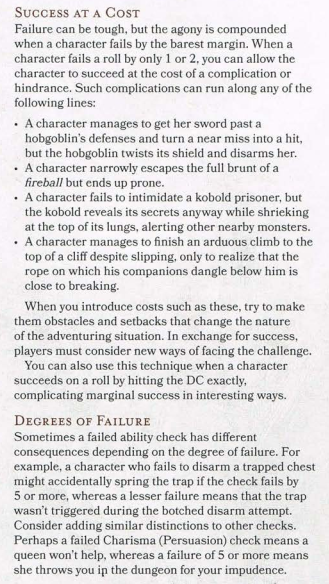I recently read an article on Kotaku that outlined why 5E D&D is deeply flawed, and it had some pretty interesting takes on it. Even as a fan of 5E, I found myself agreeing with some of the points within it. So, what is wrong with combat, and how can some 5E alternate combat rules make the game feel so much more rewarding for your group?
Whether you are playing at the table or are utilizing a Virtual Tabletop solution, these alternate combat rules can be applied.
The Problem With 5E Combat Rules – Armor Class and Saving Throws

There are times in combat within 5E that feel excessively frustrating or unrewarding. This is particularly true when your hit die rolled just under the armor class of your opponent, which results in a complete miss in most situations.
We’ve all been there.
The problem lies in how the armor class system is handled. As the rules go in most groups, anything that meets or exceeds the AC is a success, with a natural 20 being a critical success with extra effects. Anything below the threshold is a complete failure, with natural 1’s being a critical failure with extra consequences.
Using the traditional approach, failing an AC check of 12 by one or two points is exceptionally frustrating. Under the conventional combat rules that don’t consider success at a cost, that 11 roll is as valuable as a 2.
This is where Success at a cost, or partial successes that the Kotaku article I read highlighted, would come in.
Partial Success is Actually in the DMG

According to that article, the 5E DM’s guide does include a reference to partial successes, which they call success at a cost, but they don’t say what page you can find it on. So I looked through the entire book and found it on page 242. It reads:
Success at a cost:
Failure can be tough, but the agony is compounded when a character fails by the barest margin. When a character fails a roll by only 1 or 2, you can allow the character to succeed at the cost of a complication or hindrance. Such complications can run along any of the following lines:
• A character manages to get her sword past a hobgoblin’s defenses and turn a near miss into a hit, but the hobgoblin twists its shield and disarms her.
• A character narrowly escapes the full brunt of a fireball but ends up prone.
• A character fails to intimidate a kobold prisoner, but the kobold reveals its secrets anyway while shrieking at the top of its lungs, alerting other nearby monsters.
• A character manages to finish an arduous climb to the top of a cliff despite slipping, only to realize that the rope on which his companions dangle below him is close to breaking.Dungeon Master’s Guide Page 242
When you introduce costs such as these, try to make them obstacles and setbacks that change the nature of the adventuring situation. In exchange for success, players must consider new ways of facing the challenge. You can also use this technique when a character succeeds on a roll by hitting the DC exactly, complicating marginal.
I believe that this concept has been highly underutilized in many DND groups. And as pointed out in the article on Kotaku, I think it has to do with the fact that this little bit of text is glossed over by many DMs. It isn’t exactly a large section, and it isn’t talked about very often in the DND community. (That I have seen anyway.)
Partial Successes Outlined in a Framework
Kotaku raised a good point, though – there is no framework in the DMG that outlines how you can deal with partial successes. This is probably a large contributing factor to why this feature is so obscure.
So I’m going to provide for you a framework to which you can apply this partial success mechanic to your group. Let me know if anything doesn’t quite make sense to you, and I’ll try to clarify it.
First, let’s address when a Partial Success comes into play:
- If a player fails the hit check by a maximum of 2 points, then a player can opt into the chance to score a hit, and potentially deal with some consequences.
- If they choose to go for it, proceed to the tables below.
- If they choose to take the miss and not chance any ill effects, accept the miss.
What better way to build a framework than by creating a D100 effects table? I like to roll my D100, so it just seemed like the natural choice.
Melee Partial Successes Table
You are free to modify any of these outcomes that are too punishing (or not punishing enough) for your taste. But, remember, your players are the ones that need to contend with these drawbacks. So make sure they are comfortable with them before you enforce it.
And remember, this goes both ways – enemies can get partial successes too. It’s only fair! 🙂
| Dice Roll (D100) | Effects of Partial Success (Melee Attack Table) |
|---|---|
| 00-10 | The attack succeeds. Your damage is reduced by half in a glancing blow. It cannot be reduced to less than 1 damage. |
| 11-20 | The attack succeeds, but your weapon gets knocked out of your hands due to the poor angle of attack. (Inflicts Disarm Condition) | DC 11 Dexterity saving throw. | (If the player is executing an unarmed strike of some kind, Refer to 31-40.) |
| 21-30 | The attack succeeds, but you trip on a (insert appropriate terrain obstacle or their own feet if you can’t think of anything cool) as you step in to make the attack. (Inflicts Prone Condition.) | DC 11 Dexterity saving throw to stay on feet. | |
| 31-40 | The attack succeeds, but the (opponent type/name) weathers the attack, shoving their weight against your blow. As a result, you get pushed back 5 feet. (No attack of opportunity because they are using everything to resist the strike.) | DC 11 Strength saving throw against knockback. | |
| 41-50 | The attack succeeds, but your weapon gets stuck in your opponent. Spend a bonus action to dislodge it, which guarantees a hit. (If the player is executing an unarmed strike of some kind, Refer to 00-10 or 71-80) |
| 51-60 | The attack succeeds, but the enemy grapples you. | DC 11 Strength saving throw. | (If creature type is incapable of grappling, refer to 00-10) |
| 61-70 | The attack succeeds, but the enemy manages to try and return a hit of their own after you overextended your strike. | DC 11 Dexterity saving throw. | (On saving throw failure: Roll a D20 with disadvantage for their hit chance since they just took a hit.) |
| 71-80 | The attack succeeds, but dust kicked up by battle gets in your eyes, blinding you. (Inflicts Blinded Condition for two turns. Can Spend a bonus action to wipe eyes to reduce the effect to one turn.) | DC 11 Constitution Saving throw to avoid this effect. | (If the player is permanently blinded due to backstory, No effect.) |
| 81-90 | The attack succeeds, but the tenacity of your opponent surprises you, leaving you frightened. | DC 11 Wisdom saving throw. | |
| 91-100 | The attack succeeds as usual, with no ill effects. (Distracted enemy? Flavor it up) |
Ranged Partial Successes Table
The Ranged table was a bit of a challenge to come up with because simple ideas like disarming or being grappled aren’t really an option as a consequence. The most basic substitution would be that your munition was destroyed on impact, but that left one other option to fill in.
Then, it hit me! Or rather, it hit someone else who wasn’t your target. This is quite a comical outcome for partial success because it means you can hit other enemies that are within 30 feet of your main target. Or allies. There is a story behind this from one of my recent sessions running the Dragon of Icespire peak module…
| Dice Roll (D100) | Effects of Partial Success (Ranged Attack Table) |
|---|---|
| 00-10 | The attack succeeds, but it only grazes your opponent, dealing 1 (weapon damage type) damage. |
| 11-20 | The attack succeeds, but it grazes your opponent, dealing half your rolled damage to a minimum of 1 (weapon damage type) damage |
| 21-30 | The attack succeeds, but your footing is poor. You twist your ankle on a(n) (appropriate terrain obstacle) as you make your attack. Your movement is reduced by half for two turns. | DC 11 Dexterity saving throw. | |
| 31-40 | The attack succeeds, but the (opponent type/name) rips your (appropriate missile type) out and glares at you menacingly. (Inflicts Frightened Condition) | DC 11 Wisdom Saving throw. | |
| 41-50 | The attack succeeds, but the ammunition is broken on impact, becoming unrecoverable after the battle. |
| 51-60 | The attack succeeds, but the wind picks up, and you get dust in your eye, blinding you. (Inflicts Blinded Condition for two turns. Can Spend a bonus action to wipe eyes to reduce the effect to one turn.) | DC 11 Constitution Saving throw to avoid this effect. | (If the player is permanently blinded due to backstory, No effect.) |
| 61-70 | The attack succeeds, but the opponent manages to try and return a hit of their own. (If they have a ranged implement or can cast a cantrip as a reaction) (Opponent has disadvantage to hit in their reaction attack.) (If no ranged option available, see 00-10 or 21-30.) |
| 71-80 | The attack succeeds, but not against your intended target. (Hits another that is within 30 feet around your main target instead. Can hit allies.) (See 41-50 if too harsh.) |
| 81-90 | The attack succeeds, but your bowstring slaps your wrist, inflicting 1 bludgeoning damage. Alternate for other Weapon types: – but your crossbow shaft splinters into your finger, inflicting 1 piercing damage. – but you fumble your sling, and the sling handle hits you in the eye, inflicting 1 bludgeoning damage. – but a(n) (Insert throwing weapon) in your pocket misaligns itself, and punctures your body, inflicting 1 piercing damage. – but the gun you fired burned your hand, inflicting 1 fire damage. (I think that covers every ranged weapon type. Essentially, make it hit them for 1 damage) |
| 91-100 | The attack succeeds as usual, with no ill effects. (Distracted enemy? Flavor it up) |
Magic Partial Successes Table
Just a heads up, I’m not 100% satisfied with the magic partial success table. It was difficult for me to come up with drawbacks for magic that weren’t overly punishing for the player in this case. If you have any suggestions on improving this, I’m more than open to them! Let me know in the comments.
They aren’t that bad, but they are a bit harsher than the ranged table because magic lacks that whole ammunition aspect. I tried to make it make sense for the theme of magic, but I don’t think I did the best job of coming up with drawbacks.
| Dice Roll (D100) | Effects of Partial Success (Magic Attack Table) |
|---|---|
| 00-10 | The attack succeeds, but you didn’t quite cast the spell correctly. As a result, you take 1d4 Psychic damage. | DC 11 Constitution saving throw to negate this effect. | |
| 11-20 | The attack succeeds, but your spell casting didn’t go well, and its potency was less effective. (Half Damage.) Minimum of 1 damage |
| 21-30 | The attack succeeds, but your footing is poor, and you twist your ankle on a(n) (appropriate terrain obstacle, or their own feet) as you make your attack. (Movement is reduced by half for two turns.) | DC 11 Dexterity saving Throw. | |
| 31-40 | The attack succeeds, but the enemy manages to try and return a hit of their own. (If they have a ranged implement or can cast a cantrip as a reaction) (Opponent has disadvantage to hit in their reaction attack.) (If no ranged option available, see 00-10 or 61-70.) |
| 41-50 | The attack succeeds, but the enemy lets out an ear-piercing cry of anger and glares menacingly at you. (Inflicts Frightened Condition.) | DC 11 Wisdom saving throw. | |
| 51-60 | The attack succeeds, but the wind picks up, and you get dust in your eye, blinding you. (Inflicts Blinded Condition for two turns. Can Spend a bonus action to wipe eyes to reduce the effect to one turn.) | DC 11 Constitution Saving throw to avoid this effect. | (If the player is permanently blinded due to backstory, No effect.) |
| 61-70 | The Attack Succeeds. Barely. Only inflicts 1 (appropriate spell damage type) damage. |
| 71-80 | The attack succeeds but misses. Instead, your opponent becomes frightened of you because of how close it was to hitting them. (Inflicts Frightened Condition.) | DC 11 Wisdom saving throw. | (Refer to 21-30 if the monster type is immune to frightened.) |
| 81-90 | The attack succeeds, but not against your intended target. (Hits another that is within 30 feet around your main target instead. Can hit allies.) (See 41-50 if too harsh.) |
| 91-100 | The attack succeeds as usual, with no ill effects. (Distracted enemy? Flavor it up) |
How These Rules Speed up Combat

These 5E alternate combat rules speed up combat by simply increasing the damage output of your party (and enemies) by allowing an attack that would have missed to go through. Of course, as the DMG states, this partial success has drawbacks associated with it.
I like the chaos factor of the wild magic sorcerer I play in one of my groups. When I read that article on Kotaku that brought this mechanic to my attention, my mind immediately went to a D100 table. I really like the idea of partial successes, as completely missing out on your damage because you were only JUST under their AC is demoralizing.
Especially when it happens back to back. Shudders…
Remember, these rules also apply to the party’s enemies – they too can also get partial successes. It’s only fair. 🙂
I’ve classified this article as “homebrew” because while the partial success feature is an official canon part of 5e, these tables were born from my imagination on how I envision the drawbacks associated with it. With that said, I do feel that many groups forget this feature exists. At least every group that I have been a part of.
Now, I don’t currently have tables for partial saving throws yet because I’m not quite sure how I want to approach that subject. But I wanted to release this outline on partial successes using these tables as a framework. When the saving throws tables have been worked out, I’ll update this post with them. Again, if you have any suggestions in this regard, I’m more than happy to see what approaches you have in mind. Let me know in the comments!
Also, I don’t really like the standpoint that the author took on 5E – “It’s flawed, so use something else!” Erm… That isn’t a good solution. There are plenty of great homebrew rules you can incorporate to fix some of the really glaring flaws, and 5E is really approachable for new players who aren’t interested in the rules and just want to have a good time playing through a storytelling adventure with their friends.





